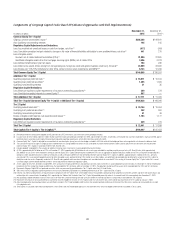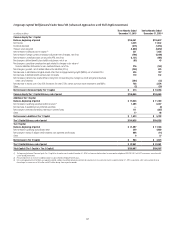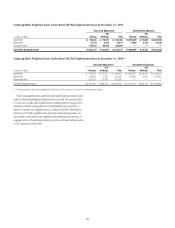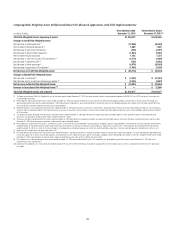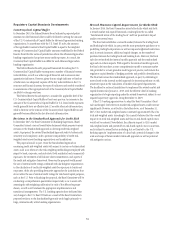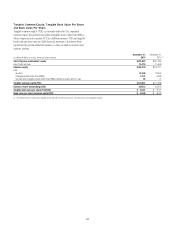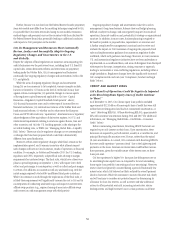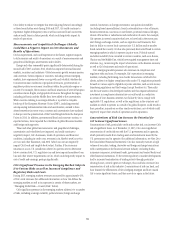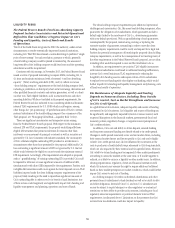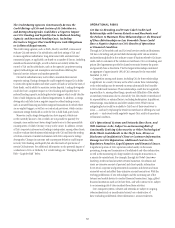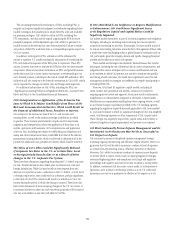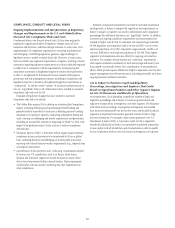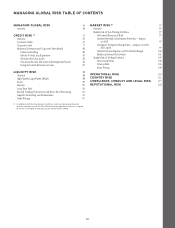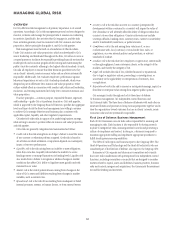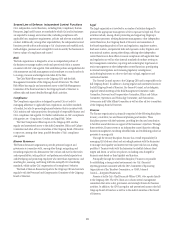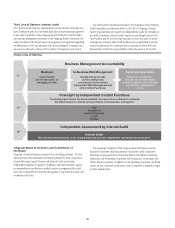Citibank 2015 Annual Report Download - page 74
Download and view the complete annual report
Please find page 74 of the 2015 Citibank annual report below. You can navigate through the pages in the report by either clicking on the pages listed below, or by using the keyword search tool below to find specific information within the annual report.56
LIQUIDITY RISKS
The Federal Reserve Board’s Total Loss-Absorbing Capacity
Proposal Includes Uncertainties and Potential Operational
Difficulties That Could Have a Negative Impact on Citi’s
Funding and Liquidity, Costs of Funds and Results
of Operations.
Title II of the Dodd-Frank Act grants the FDIC the authority, under certain
circumstances, to resolve systemically important financial institutions,
including Citi. The FDIC has released a notice describing its preferred “single
point of entry strategy” for such resolution, pursuant to which, generally,
a bank holding company would be placed in receivership, the unsecured
long-term debt of the holding company would bear losses and the operating
subsidiaries would be recapitalized.
Consistent with this strategy, in November 2015, the Federal Reserve Board
issued a notice of proposed rulemaking to require GSIBs, including Citi, to
(i) issue and maintain minimum levels of external “total loss-absorbing
capacity” (TLAC) and long-term debt (LTD), and (ii) adhere to various
“clean holding company” requirements at the bank holding company level,
including a prohibition on third-party short-term borrowings, derivatives and
other qualified financial contracts and certain guarantees, as well as a limit
on other non-TLAC eligible liabilities, such as structured notes and other
operating liabilities. While not included in its proposed requirements, the
Federal Reserve Board also indicated it was considering additional domestic
internal TLAC requirements for U.S. GSIBs which could require, among
other things, the “pre-positioning” of specified amounts of TLAC to certain
material subsidiaries of the bank holding company (for a summary of the
TLAC proposal, see “Managing Global Risk—Liquidity Risk” below).
There are significant uncertainties and interpretive issues arising
from the Federal Reserve Board’s proposal. With respect to the minimum
external LTD and TLAC requirements, the proposal would disqualify from
eligible LTD securities that permit acceleration for reasons other than
insolvency or non-payment of principal or interest as well as securities not
governed by U.S. law. Consistent with industry standards, the vast majority
of Citi’s otherwise eligible outstanding LTD provides for acceleration in
circumstances other than those permitted by the proposal. Additionally, Citi
has outstanding a significant amount of LTD not governed by U.S. law but
which would otherwise be eligible to count towards the minimum external
LTD requirement. Accordingly, if the requirements are adopted as proposed,
and no “grandfathering” of existing outstanding LTD is provided, Citi could
be required to refinance or issue significant amounts of additional debt,
simultaneously with other GSIBs impacted by the requirements. Further, such
ineligible debt securities would count against the limit imposed on non-TLAC
liabilities imposed under the clean holding company requirements of the
proposal, likely resulting in the need to repurchase significant amounts of
Citi’s outstanding debt in order not to be in breach of such limitations. Any
of these actions could negatively and significantly impact Citi’s funding and
liquidity management and planning, operations and costs of funds.
The clean holding company requirements pose additional operational
challenges and uncertainties. Citi, like many bank holding companies, often
guarantees the obligations of its subsidiaries, which guarantees include a
default right linked to the insolvency of Citi (i.e., downstream guarantees
with cross-default provisions). With no grandfathering of such guarantees
contemplated by the proposal, restructuring, revising or replacing the
extensive number of guarantees outstanding in order to meet the clean
holding company requirements could be costly and expose Citi to legal risk.
Further, the potential consequences of breaching the proposed clean holding
company requirements, as well as the consequences of not meeting many of
the other requirements in the Federal Reserve Board’s proposal, are not clear,
including what would be required to cure and the timeframe to do so.
In addition, any requirement to pre-position TLAC-eligible instruments
with material subsidiaries could result in additional funding inefficiencies,
increase Citi’s overall minimum TLAC requirements by reducing the
fungibility of its funding sources and require certain of Citi’s subsidiaries
to replace lower cost funding with other higher cost funding, which would
further impede Citi’s funding and liquidity management and planning, costs
of funds and results of operations.
The Maintenance of Adequate Liquidity and Funding
Depends on Numerous Factors, Including Those Outside
of Citi’s Control, Such as Market Disruptions and Increases
in Citi’s Credit Spreads.
As a global financial institution, adequate liquidity and sources of funding
are essential to Citi’s businesses. Citi’s liquidity and sources of funding can
be significantly and negatively impacted by factors it cannot control, such
as general disruptions in the financial markets, governmental fiscal and
monetary policies, regulatory changes or negative investor perceptions of
Citi’s creditworthiness.
In addition, Citi’s cost and ability to obtain deposits, secured funding
and long-term unsecured funding are directly related to its credit spreads.
Changes in credit spreads constantly occur and are market driven, including
both external market factors and factors specific to Citi, and can be highly
volatile. Citi’s credit spreads may also be influenced by movements in the
costs to purchasers of credit default swaps referenced to Citi’s long-term debt,
which are also impacted by these external and Citi-specific factors. Moreover,
Citi’s ability to obtain funding may be impaired if other market participants
are seeking to access the markets at the same time, or if market appetite is
reduced, as is likely to occur in a liquidity or other market crisis. In addition,
clearing organizations, regulators, clients and financial institutions with
which Citi interacts may exercise the right to require additional collateral
based on these market perceptions or market conditions, which could further
impair Citi’s access to and cost of funding.
As a holding company, Citi relies on dividends, distributions and other
payments from its subsidiaries to fund dividends as well as to satisfy its debt
and other obligations. Several of Citi’s U.S. and non-U.S. subsidiaries are
or may be subject to capital adequacy or other regulatory or contractual
restrictions on their ability to provide such payments, including any local
regulatory stress test requirements or potential domestic internal TLAC
requirements (as discussed above). Limitations on the payments that Citi
receives from its subsidiaries could also impact its liquidity.


